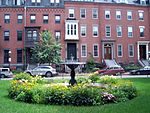National Theatre (Boston, 1911)
The National Theatre (1911-1978) of Boston, Massachusetts, was a 3,500-seat multipurpose auditorium on Tremont Street in the South End. It functioned as a cinema, lecture hall, and stage. Performers included Jehovah's Witness founder Joseph F. Rutherford and "big-name entertainers like Duke Ellington and Ray Bolger." Movie screenings included The Battle of Gettysburg in 1913. The English High School held graduation exercises in the National. Around 1919 it was known as the "Waldorf Theater." In 1992, it was purchased by Philip Smith.The space operated "intermittently after World War II for plays and movies." Among the audience members: clothing designer Joseph Abboud. The National closed in 1978. The Boston Center for the Arts oversaw the property thereafter, when it was subject to numerous plans for redevelopment. The building existed until 1997, when it was demolished.
Excerpt from the Wikipedia article National Theatre (Boston, 1911) (License: CC BY-SA 3.0, Authors).National Theatre (Boston, 1911)
Tremont Street, Boston South End
Geographical coordinates (GPS) Address Nearby Places Show on map
Geographical coordinates (GPS)
| Latitude | Longitude |
|---|---|
| N 42.344763888889 ° | E -71.071008333333 ° |
Address
Atelier 505
Tremont Street 505
02116 Boston, South End
Massachusetts, United States
Open on Google Maps






